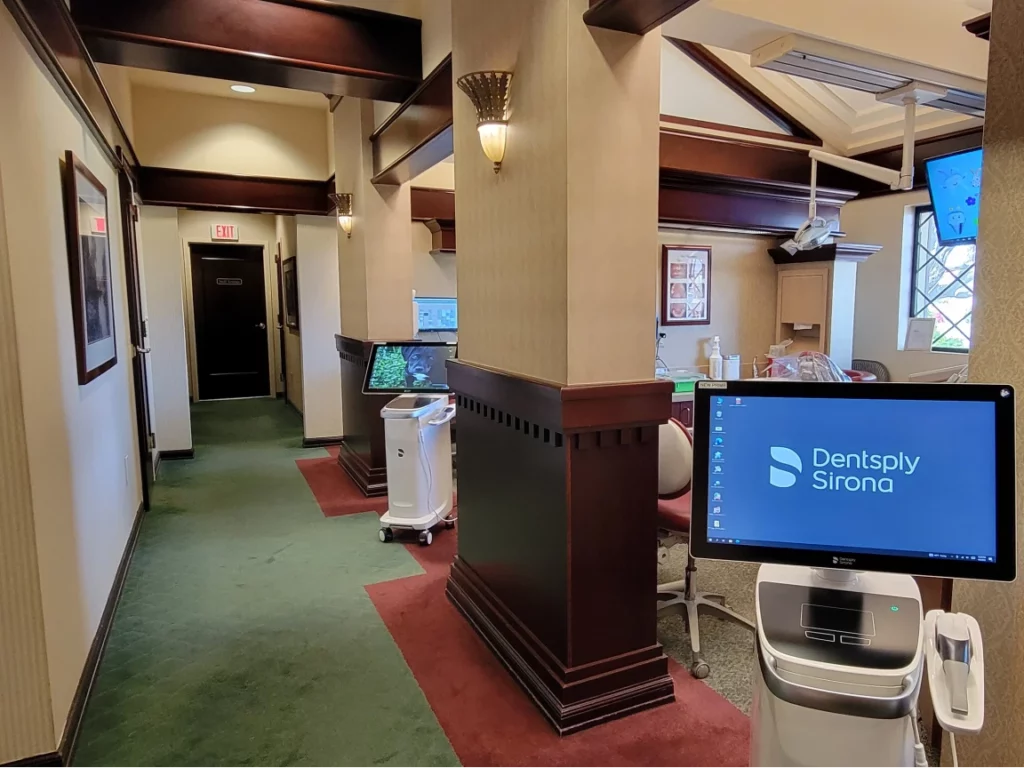A root canal is a very common dental procedure performed in order to help save your natural teeth and prevent the need for dental implants and bridges.
At the center of each of your teeth is the dental pulp (tooth nerve). Infection of the dental pulp can be very painful and is caused by a variety of factors including: trauma, deep cavities, cracks in the tooth, or repeated dental procedures.
If you do find yourself with a painful toothache, we encourage you to call our dental office right away. An infected tooth that is not treated can only result in bigger problems. Contact Arrowhead Ranch Dentistry at (602) 843-0010 for prompt and comfortable emergency care.
The nerve of a tooth functions to provide hot and cold sensation, but other than that, it is not necessary to the tooth’s overall health and function.
If a tooth has a large cavity or is cracked, bacteria can enter the dental pulp and cause an infection. If not treated, that infection can cause an abscess, resulting in pain, swelling, and further deterioration of the tooth. Not only can the infected tissue injure your jawbones and surrounding teeth, it can also be detrimental to your overall health.
Teeth that need root canal therapy are not always painful, but common symptoms of an infected pulp include: biting pain, visible swelling, obvious damage or decay to the tooth, temperature sensitivity, lingering or spontaneous pain, discoloration of the tooth, discomfort that wakes you up in the middle of the night, or tenderness in the neighboring gums.
Root canal treatment is completed utilizing local anesthesia where the doctor removes the diseased nerve from the tooth. After the infected tissue is removed, the tooth is cleaned and sealed. Next, the tooth is built up with white filling material. A crown is typically placed over the large filling in order to protect the tooth and help prevent future breakage.
While many teeth can be saved with root canal therapy, some teeth do require extraction if the chances of success with endodontic treatment are unfavorable or if complications become evident during or after treatment.
There are several signs that may indicate you need a root canal, including:
If you experience any of these symptoms, it’s important to give Arrowhead Ranch Dentistry a call as soon as possible. Dr. Dockstader or Dr. Nguyen will examine your tooth and determine if a root canal is necessary to save the tooth and prevent further complications.
If you’re looking for a root canal dentist near you, you’re in the right place! Dr. Dockstader and Dr. Nguyen treat teeth in need of a root canal and are conveniently located right here in Glendale. However, some teeth require more complex treatment and equipment. In complex cases, our doctors will refer you to their trusted Endodontist colleagues who specialize in root canals. We reserve space on our schedule for emergency dental appointments, so if you need an emergency root canal near you, we’ll make sure to get you in ASAP!
After an emergency root canal procedure, it is normal to experience some pain and discomfort for a few days. However, there are several things you can do to manage your symptoms and promote healing:
If you experience severe pain, swelling, or bleeding after a root canal procedure, or if your symptoms do not improve after a few days, please contact Arrowhead Ranch Dentistry and we will address your concerns right away.
Root canal recovery time can vary depending on the severity of the infection, the complexity of the procedure, and the individual’s overall health. In general, it’s common to experience some pain and discomfort for a few days after the procedure.
Most people are able to return to their normal activities, including work or school, within a day or two after the procedure. However, it is recommended to avoid strenuous physical activity for a few days and to eat soft foods to avoid putting pressure on the affected tooth.
Common symptoms of root canal recovery include:
In most cases, the tooth will feel completely normal within a few days to a week after the root canal procedure. It’s important to attend follow-up appointments to ensure proper healing and to address any concerns or issues that may arise.
Avoiding a root canal involves maintaining good oral hygiene and taking care of your teeth and gums. Here are some hygiene tips that can help you avoid a root canal:
By following these hygiene tips, you can help prevent the need for a root canal and maintain a healthy smile.
While root canal procedures are often the best option for saving a severely damaged or infected tooth, there are a few alternatives to root canals that may be considered depending on the individual case. These alternatives include:
It’s important to note that while these alternatives may be considered in some cases, a root canal is often the most effective way to save a damaged or infected tooth and prevent the need for an extraction. If you’re experiencing dental pain or other symptoms, please call Arrowhead Ranch Dentistry right away and Dr. Dockstader and Dr. Nguyen will be able to determine the best course of treatment for your individual case.
Many people ask if root canals are painful. The answer is that while the procedure itself is not painful, some patients may experience some discomfort or sensitivity during or after the procedure.
During a root canal procedure, Dr. Dockstader and Dr. Nguyen will numb the area around the affected tooth with a local anesthetic. This helps to prevent pain during the procedure. Some patients may feel a slight pressure or vibration during the procedure, but it should not be painful.
After the procedure, it is common to experience some discomfort or sensitivity in the treated tooth for a few days. This can usually be managed with over-the-counter medications, such as ibuprofen or acetaminophen. Dr. Dockstader and Dr. Nguyen may also prescribe medication if necessary.
Overall, while a root canal procedure may be uncomfortable or cause some sensitivity, it should not be painful. The benefits of saving a damaged or infected tooth through a root canal procedure far outweigh any temporary discomfort.
Our patients are our biggest fans. Here are a few highlights from our public reviews.
Monday
7:00AM – 3:30PM
Tuesday
7:00AM – 3:30PM
Wednesday
8:00AM – 4:30PM
Thursday
7:00AM – 3:30PM
Friday
7:00AM – 3:30PM
Saturday
CLOSED
Sunday
CLOSED
Copyright © 2023 Arrowhead Ranch Dentistry | Privacy Policy | Website by Elementus Media Group
We are happy to answer your questions. Please fill out our contact form and we will get back to you shortly!


